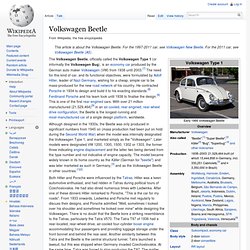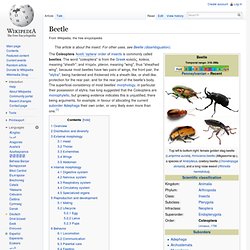

Volkswagen Beetle. The Volkswagen Beetle, officially called the Volkswagen Type 1 (or informally the Volkswagen Bug), is an economy car produced by the German auto maker Volkswagen (VW) from 1938 until 2003.[7] The need for this kind of car, and its functional objectives, were formulated by Adolf Hitler, leader of Nazi Germany, wishing for a cheap, simple car to be mass-produced for the new road network of his country.

He contracted Porsche in 1934 to design and build it to his exacting standards.[8] Ferdinand Porsche and his team took until 1938 to finalise the design.[8] This is one of the first rear-engined cars. With over 21 million manufactured (21,529,464)[9] in an air-cooled, rear-engined, rear-wheel drive configuration, the Beetle is the longest-running and most-manufactured car of a single design platform, worldwide. The Beetle was designed for sustained high speed on the Autobahn. It ultimately gave rise to variants, including the Volkswagen Karmann Ghia and the Volkswagen Type 2 bus. Old vs New: 2012 Volkswagen Beetle. How to disassemble a beetle in just 20 seconds!!!! Incredible beetle crash commercial! How long does a vw beetle float? Just watch! Beetle. Overview[edit] The Coleoptera include more species than any other order, constituting almost 25% of all known types of animal life-forms.[2][3][4] About 40% of all described insect species are beetles (about 400,000 species[5]), and new species are discovered frequently.

Some estimates put the total number of species, described and undescribed, at as high as 100 million, but a figure of one million is more widely accepted.[6] The largest taxonomic family is commonly thought to be the Curculionidae (the weevils or snout beetles), but recently the Staphylinidae (the rove beetles) have claimed this title. [citation needed] The diversity of beetles is very wide. They are found in all major habitats, except marine and the polar regions. Conversely, beetles are prey of various invertebrates and vertebrates, including insects, fish, reptiles, birds, and mammals.
Species in the Coleoptera have a hard exoskeleton, particularly on their forewings (elytra, singular elytron). Head[edit] Thorax[edit] Beetle-fight-competition.mov. General body structure of beetles. Body normally oval, elongated oval or elongated, relatively convex from above with strongly sclerotized integuments and appendages, including elytra covering membranized tergites of the abdomen.

Firm exoskeleton permits analogies with some reptiles (in particular with tortoises) or mammals (e.g. armadillos), but particularly many parallels are observed among different arthropods in particular in the orders of earwigs, cockroachers, bugs, Homoptera, etc. Hard wing syndrome in insects has its basis similar t o that in tortoises and armadillos and is defined by passive defence. In vertebrates the function of protection against predators prevails. In insects, however, this is a form of body protection (particularly of soft tergites of the abdomen) against action of substratum when insects move inside it.
Body shape reveals a wide range of variation so that in some cases adult beetles with most reduced elytra are not even recognized as such and are placed in the order of sylopids. A.G.